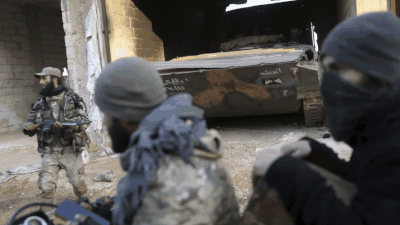
In a significant escalation of Syria's prolonged civil war, rebels breached the city of Aleppo on Friday, claiming control of large swathes of territory. The offensive, spearheaded by groups including
Hayat Tahrir al-Sham
(HTS), marks the most intense fighting the region has witnessed in years.
Rebels claim control of Aleppo neighbourhoods
According to the Syrian observatory for human rights, a UK-based war monitor, the rebels swiftly captured more than half of Aleppo without resistance from government forces. Videos and images shared by independent Syrian media depicted rebels celebrating in Aleppo neighbourhoods and at key landmarks.
However, Syrian state media refuted these claims, asserting that government forces apprehended several "terrorists" who were filming videos in neighborhoods to prove that they had taken control of them.
Government response: Airstrikes and detentions
In retaliation, Syrian government forces, backed by Russian airpower, launched a series of intense strikes on opposition-held areas. The observatory reported 23 airstrikes on the city of Idlib and confirmed that Russian forces captured over 200 rebels in the Aleppo and Idlib suburbs during joint operations with the Syrian military.
Anti-government factions detonated two car bombs targeting government soldiers in western Aleppo, breaching five neighbourhoods, the observatory reported. Meanwhile, the Syrian state news agency SANA said that rebel attacks on Aleppo University killed four civilians.
Aleppo in crisis: Hospitals near capacity
The United Nations office for the coordination of humanitarian affairs (OCHA) highlighted the dire humanitarian situation in Aleppo, reporting the closure of its international airport and some hospitals. The remaining hospitals are nearing capacity, while security conditions within the city continue to deteriorate.
Wider implications and international concerns
The timing of the rebel offensive has raised questions about its connection to broader regional dynamics. Iran, a key ally of Syrian President Bashar Assad, has seen its influence strained due to conflicts involving its proxies, Hezbollah and Hamas. These groups, along with the Assad regime, form an "axis of resistance" that has faced setbacks amid ongoing Israeli strikes and the war in Gaza.
At the same time, Russia, another major backer of Assad, remains entangled in the Ukraine conflict, potentially reducing its capacity to intervene effectively in Syria.
Civil war resurfaces after years of stalemate
The Syrian civil war, which began in 2011, has displaced millions and devastated the country. While the conflict had largely stagnated in recent years, Friday's developments echo earlier phases of the war, with rebels capturing territories and issuing calls for government defections.
The current escalation follows a ceasefire brokered in 2020 by Russia and Turkey, which had largely frozen the conflict. Over three days of clashes, over 250 combatants from both sides have been killed, according to the observatory, along with multiple civilian casualties reported by the White Helmets, a rescue organisation in opposition-held areas.
Rebel goals and government counterclaims
Rebels have framed their offensive as a response to escalating airstrikes on opposition-held areas. Lt Col Hassan Abdulghany, a military commander for the opposition, said in a video message, “It is an obligation to defend our people and their land.”
Meanwhile, Syrian state media claimed that government forces repelled the rebel advance and inflicted heavy losses, though these assertions remain unverified.
A fragile balance
The resurgence of large-scale conflict in Aleppo underscores the fragility of Syria's tenuous peace and highlights the vulnerabilities of Assad’s regime. Mohammed Alaa Ghanem, a senior policy adviser for a Syrian advocacy group, noted that the events "expose Assad's deep vulnerabilities and his regime's lack of popular legitimacy."
As fighting rages on, Aleppo and its inhabitants brace for an uncertain future, with renewed violence threatening to upend years of relative calm in Syria’s devastated landscape.

 3 weeks ago
11
3 weeks ago
11









